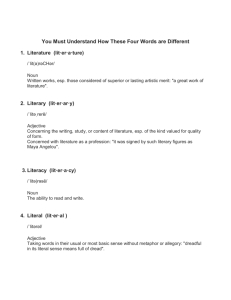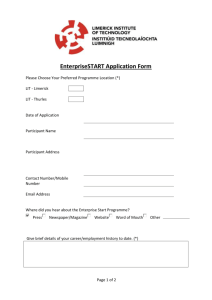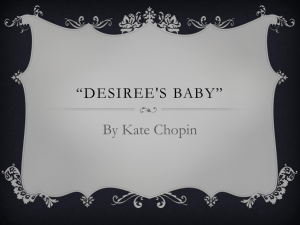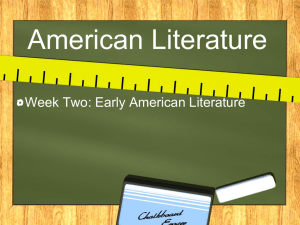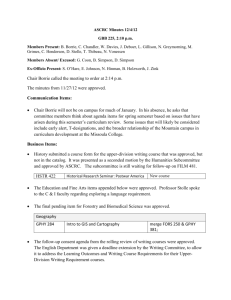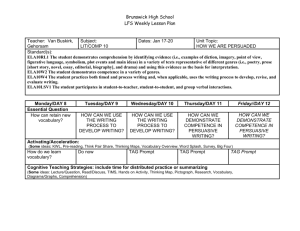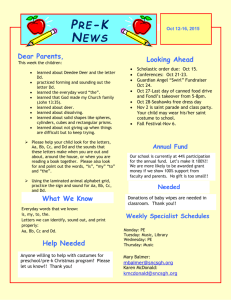LTRC 517 - Binghamton
advertisement
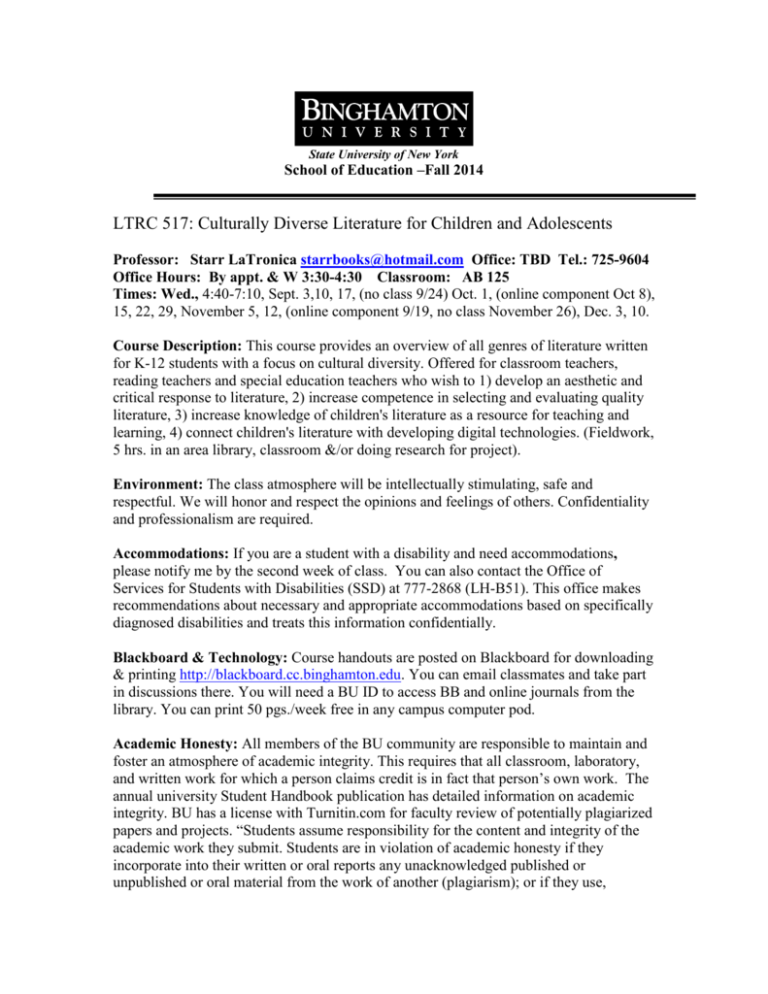
State University of New York School of Education –Fall 2014 LTRC 517: Culturally Diverse Literature for Children and Adolescents Professor: Starr LaTronica starrbooks@hotmail.com Office: TBD Tel.: 725-9604 Office Hours: By appt. & W 3:30-4:30 Classroom: AB 125 Times: Wed., 4:40-7:10, Sept. 3,10, 17, (no class 9/24) Oct. 1, (online component Oct 8), 15, 22, 29, November 5, 12, (online component 9/19, no class November 26), Dec. 3, 10. Course Description: This course provides an overview of all genres of literature written for K-12 students with a focus on cultural diversity. Offered for classroom teachers, reading teachers and special education teachers who wish to 1) develop an aesthetic and critical response to literature, 2) increase competence in selecting and evaluating quality literature, 3) increase knowledge of children's literature as a resource for teaching and learning, 4) connect children's literature with developing digital technologies. (Fieldwork, 5 hrs. in an area library, classroom &/or doing research for project). Environment: The class atmosphere will be intellectually stimulating, safe and respectful. We will honor and respect the opinions and feelings of others. Confidentiality and professionalism are required. Accommodations: If you are a student with a disability and need accommodations, please notify me by the second week of class. You can also contact the Office of Services for Students with Disabilities (SSD) at 777-2868 (LH-B51). This office makes recommendations about necessary and appropriate accommodations based on specifically diagnosed disabilities and treats this information confidentially. Blackboard & Technology: Course handouts are posted on Blackboard for downloading & printing http://blackboard.cc.binghamton.edu. You can email classmates and take part in discussions there. You will need a BU ID to access BB and online journals from the library. You can print 50 pgs./week free in any campus computer pod. Academic Honesty: All members of the BU community are responsible to maintain and foster an atmosphere of academic integrity. This requires that all classroom, laboratory, and written work for which a person claims credit is in fact that person’s own work. The annual university Student Handbook publication has detailed information on academic integrity. BU has a license with Turnitin.com for faculty review of potentially plagiarized papers and projects. “Students assume responsibility for the content and integrity of the academic work they submit. Students are in violation of academic honesty if they incorporate into their written or oral reports any unacknowledged published or unpublished or oral material from the work of another (plagiarism); or if they use, request, or give unauthorized assistance in any academic work (cheating).” (SOE Academic Honesty Policies). Plagiarism, cheating or unethical behavior such as handing in the same or slightly altered assignment for two courses will not be tolerated. Incidents of these types will result in a failing grade for the assignment/s in question, and will have a negative effect on the final grade. If you have questions about what constitutes plagiarism, go to http://writingcenter.binghamton.edu/handout.html. Required Text: None. Students will select a volume of professional reading(s) and present a synopsis and analysis to the class. Required subscription to online discussion list: http://ccbc.education.wisc.edu/ccbcnet/default.asp and twitter thread #weneeddiversebooks, and http://americanindiansinchildrensliterature.blogspot.com Required Children’s Books: These will be supplemented with individual choices that reflect the students’ specialty. Alexie, S. (2007). The absolutely true diary of a part-time Indian. New York: Little Brown. Atinuke. (2010) Anna Hibiscus. Kane Miller. Bartoletti, Susan. (2006) Hitler youth. Scholastic. Curtis, Christopher Paul. (2000) The Watsons go to Birmingham-1963. Random. Grimes, N. (2001). Bronx masquerade. New York: Dial. (Coretta Scott King Award). Look, Lenore. (2009) Alvin Ho: Allergic to girls, school and other scary things. Random Nye, Naomi Shihab (2014) The turtle of Oman. Greenwillow. Ryan, P. (2010). The Dreamer. New York: Scholastic. Wright, Danielle (2010). My village: Rhymes from around the world. Frances Lincoln Yang, Gene Leun. (2007) American born Chinese. First Second. (Printz) Articles: (*available online from BU Library** & on Blackboard) *Bisplinghoff, B.S. (2002). Under the wings of writers: A teacher reads to find her way. The Reading Teacher, 56(3), 242-252. *Bromley, K. (2012). Smartphones=smarter students: Supplementing classroom reading with technology. Submitted to The Reading Teacher, January. *Camp, D. (2000). It takes two: Teaching with twin texts of fact and fiction. The Reading Teacher, 53(5), pp. 400-408. **Craft-Al Hazza, T., & Bucher, K.T. (2008). Building Arab Americans’ cultural identity and acceptance with children’s literature. The Reading Teacher, 62(3), 210-219. *Dutro, E. (2002). But that’s a girl’s book! Exploring gender boundaries in children’s reading practices. The Reading Teacher, 55(4), 376-84. *Goldstone, B.P. (2002). Whaz up with our books? Changing picture book codes and teaching implications. The Reading Teacher, 55, 362-9. Gill, S. (2010). What teachers need to know about new non-fiction. The Reading Teacher, 63(4), 260-269. Gritter, K. (2011). Promoting lively literature discussion. The Reading Teacher, 64 (6), 445-450. Groenke, S. & Youngquist, M. (2011). Are we post-modern yet? Reading Monster with 21st century 9th graders. Journal of Adolescent & Adult Literacy, 54 (7), 505-514. Hassett, D. & Curwood, J. (2009). Theories and practices of multimodal education: The instructional dynamics of picture books and primary classrooms. The Reading Teacher, 63(4), 270-282. *Lancia, P.J. (1997). Literary borrowing: The effects of literature on children’s writing. The Reading Teacher, 50(6), 470-475. **Leu,D.J., Castek, J., Henry, L.A., Coiro, J., & McMullan, M. (2004). The lessons children teach us: Integrating children’s literature and the new literacies of the internet. The Reading Teacher. McCall, A. L. (2010). Teaching powerful social studies ideas through literature circles. The Social Studies, 101(4), 152-159. *McElveen, S.A., & Dierking, C.C. (2001). Children’s books as models to teach writing. The Reading Teacher, 54 (4), 362-64. *Meltzer, M. (2002). A voice for justice. Language Arts, 79(5), 438-441. Mills, H., & Jennings, L. (2011). Talking about talk: Reclaiming the value and power of literature circles. The Reading Teacher,64 (8), 590-598. **Ohlsen, B. (2007). Comics return to kids stuff in new graphic novels. Bookpage. (www.bookpage.com) **Poniewizik, J. (2007). “The end of fairytales? How Shrek and friends have changed children’s stories” Time, May 21, 2007, *Rice, D. (2002). Using trade books in teaching elementary science: Facts and fallacies. The Reading Teacher, 55 (6), 552-64. **Rosenblatt, L. (1991). Literature SOS! Language Arts, 68, 444-8. *Roser, N., & Klein, S. (2002). Fostering thought, talk and inquiry: Linking literature and social studies. The Reading Teacher, 55(5), 416-26. **Soalt, J. (2005). Bringing together fictional and information texts to build comprehension. The Reading Teacher, 680-83. **Wolsey T.D. (2004). Literature discussion in cyberspace: Young adolescents using threaded discussion groups to talk about books. Reading Online, 27(4), Jan/Feb. **Wutx, J.A., & Wedick, L. (2005). Bookmatch: Scaffolding book selection for independent reading. The Reading Teacher. *Yopp, R.H., & Yopp, H.K. (2000). Sharing informational text with young children. The Reading Teacher, 53(5), pp. 410-423. Websites: Bookwink - website with videos of booktalks. www.bookwink.com American Library Association- www.ala.org IRA website- teaching ideas and lesson plans- www.readwritethink.org American Psychological Association- (APA) Guidelines - http://www.apastyle.org/ Journals: School Library Journal, The Reading Teacher, Journal of Adolescent and Adult Literacy, Teaching Exceptional Children, English Journal, Language Arts Course Goals: 1. Develop an aesthetic, efferent and critical response to culturally diverse picture books, fiction and nonfiction materials for children and youth. 2. Build competence in evaluating literary elements and writing style, as well as the art and media used in picture book illustrations. 3. Understand the theory and practice of response, discussion, and collaboration by experiencing various methods (literature circles, book clubs, buddy journals, online discussions, etc.) 4. Understand issues of censorship, stereotyping and bias. 5. Explore applications of literature from diverse perspectives for use across the curriculum. 6. Collaborate to present a project that deepens and synthesizes understanding of a topic or issue related to children and/or young adult readers and their literature. Your Goals: 1. 2. 3. Assignments: 1. Class Participation & Written Responses (includes ongoing communication with child/teen regarding reading) (20%). Participation in discussions of each required book in class and responding to readings online. Oral & written contributions should show knowledge of content, interpretation, and critical reflection. Oral sharing and attendance is essential. We will often work in groups both in class and online. 2. Author or Series Study (10%). With a partner, read and analyze books or a series that explores or features a diverse culture. Share in class October 15. Include: * Background on author/books & website info * Book topics, titles, genre, age level/s * Curriculum connections & why books are of interest to students 3. Jackdaw (5%)- Read Sharpe article “Jackdaws” and introduce a new book with a jackdaw. Gather 3-4 artifacts that convey the book’s essence. Include one thing you have created (poem, artwork, graphic organizer, character journal entry, etc.) Share Oct 22nd. 4. Booktalk (10%). Compare a fiction and a nonfiction book on the same topic. What are the strengths /drawbacks of each, potential benefits and questions they raise? Why/how might you use them together? Share in class and write a 2 pg. reflection using APA style. Sign up in advance & share Oct 29th. 5. Presentation of Professional Literature (5%). Read, prepare and present a volume of professional writing on a related topic.Sign up to share Oct.1st or Oct.15th. 6. Use Technology/Digital Media (15%) due November 12. With a partner, use Glogster, Animoto, imovie or Museum Box, or other program/app to create a digital book trailer or poster to enhance the reading of a new multi-cultural picturebook. 7. Project (30%)– Graphic organizer & references due Oct. 29 (5 pts). With 3-4 others, pose a question you have about children’s literature and gather information to find an answer. This can be a classroom or library action research project (work with children and/or teachers, e.g., make a movie, podcasts, film/book comparison, art project, virtual literature discussion group, review and compare online literary resources). Share in a presentation with class, and a 5-6 pg. paper using APA style throughout. Use content specific headings or for example: “Introduction/Question, Theory & Research, Procedure/Implementation, Results, Discussion, Implications.” We will use a rubric and peer feedback to evaluate your project. Possible Topics: (Your choice—Please get my OK before proceeding) Web Quest Book Club (start one in a school) Family literacy practices Common Core Standards and Literature Gender influences in reading choices Graphic novels and/or non-fiction Writing and Mentor Texts (Children’s literature) Enhanced audio books and/or e-books Literature based instruction for a specific grade or subject area E- readers- impact on children’s reading (CF library has 6 NOOKS) Reading Workshop Folktales across diverse cultures Movie/TV adaptations of children’s literature Sign up to present December 3 or 10 (or before). 8. Grades: 95-100 A, 90-94 A-, 86-89 B+, 83-85 B, 80-82 B-, 76-79 C+,73-75 C, 70-72 C-, - 69 F. (To be fair to everyone, points will be deducted for late work. No late work accepted after 2 wks.) 2 pts. deducted for work turned in after due date (up to I wk. late)’ 4 pts. deducted for work turned in after one week late 5 pts. deducted for work that does not reflect standard grammar, spelling, and APA style. 10 pts. deducted from course grade for an unexcused absence. Class Schedule Day/Time 1- 9/3 Reading/Discussion Book to Share -Intro/Syllabus -Examination of sample books -Distribute articles -View TED talk and discuss 2- 9/10 - Read materials distributed 9/3 and discuss. 3- 9/17 Look up Caldecott criteria on Bring in two www.ala.org/alsc Caldecott winners Participate in Award procedure 410/1 5- 10/8 (online) Assignments Due Make contact for scaffolded lit. discussion. Follow an author on Twitter Get a library card Subscribe to CCBC-net Choose professional book for review Communication to and from Lit. Partner Read and discuss: -Alvin Ho: Allergic… -Anna Hibiscus -Turtle of Oman -Lit Circle Discussions Bring an example of another book series and provide a brief introduction Professional books presentation. Communication to and from Lit. Partner Discussion of challenges to materials/Intellectual Freedom http://www.ala.org/offices/oif Read and discuss Absolutely True Diary of a Part Time Indian Read another challenged book from the ALA list and explain reasons for its controversy and explore its merits via online discussion. Communication to and from Lit. Partner 6- 10/15 Read and discuss: Bronx Masquerade, The Dreamer and My Village 7- 10/22 -Hitler Youth or Port Chicago 50 Bring in to examples of non-fiction for your grade level -Share Jackdaws Communication to and from Lit. Partner 8- 10/29 -American Born Chinese -The Watsons Go to Birmingham-1963 -Read and bring another graphic novel (may be fiction, nonfiction or beginning reader) -Graphic Organizer, plan & reference due for project -Share Booktalks Bring questions regarding the creative process Communication to and from Lit. Partner 11- 11/5 Special author guest. Author/series studies presented Communication to and from Lit. Partner Professional books presented. Communication to and from Lit. Partner Creative presentation of a picture boo 1211/12 Humor discussion/activity Focus on final projects Bring in 2 books you Communication to and from Lit. think are funny! Partner Multi-media projects due 13- 11/19 (online) Explore research/stats on www.ala.org/additup Investigate potential community partnerships. Develop an idea/strategy for family literacy www.familyreading. org and post online. Online discussion of posts/partnerships. Dec. 3 & Dec.10 Project Sharing Course Evaluation Final communication to and from Lit. Partner due Report on Twitter - Paper & Presentations - Course Evaluation
